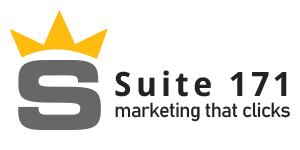How to write compelling content?
How to write compelling content
Compelling content can be more important than the product itself. The copy of your website needs to bring urgency to purchasing now. Your story must romance the buyer into purchasing from you. Now.
Suite 171 believes that you know your business better than anyone else, but sometimes clients don’t quite have the ability to write it down effectively. This is where copy-writing and content development is crucial. You could have the best product on the market and still lose website leads/customers because of your lack-luster content.
Here are five tips to keep in mind for writing your website’s content.
1. Assume your visitor has never seen or heard of your product before.
2. Know what emotional trigger your product or service fulfills and use it in the copy.
3. Are you using all three learning styles to sell your product or service?
4. Grammar, spelling, punctuation!
5. CALL TO ACTION!!!!!
1. Assume your visitor has never seen or heard of your product before.
It is a common mistake for businesses to assume that visitors are familiar with their product or service and therefore not supply enough information on their website. Often the people searching for your product or service are doing some research to learn more about you or your product. If they don’t get their questions answered in the text of your site, often they will keep looking for the answer on some other businesses website. We have seen this often with well known industries that assume their visitors already know what it is and are just looking for a phone number to call. Wrong. You can’t afford to leave money on the table by not giving enough descriptions, question and answers, photos, charts, testimonials and more. If you believe that nobody reads the content on your site so why bother… you will pay the price for being wrong.
2. Know what emotional trigger your product or service fulfills and use it in the copy.
Consumers buy products and services for many different reasons from necessity to compulsion. However the reason they choose one brand over another, one company over another or one craftsperson over another is all based on an emotional trigger. “This is the company we have always used….” is based on security and doesn’t mean you can’t convince them to choose you instead. You simply need to find the emotional trigger that makes them want to choose you more. A great resource to help you find your product or services’ emotional trigger is a book by Sally Hogshead, “Fascinate: Your 7 Triggers to Persuasion and Captivation”.
3. Are you using all three learning styles to sell your product or service?
Every human on the planet has a learning style preference, whether they know it or not. Learning styles are broken into three different categories, auditory learners, visual learners, and kinesthetic learners (people who learn by doing). Integrating elements into the content that touch all three learning styles will increase the effectiveness of your message to more people.
Auditory Learners: Some people learn more efficiently or quickly by hearing the information. These learners are auditory learners. They are the people who could listen to a lecture in school and never have to open the book, or they repeat all the best lines in the movie as you are walking out of the theatre having only seen the movie once. Often the way to reach auditory learners is through the story. Auditory learners will hear the words they are reading in their head and if you make the story interesting as someone would read it aloud, you will catch these learners. Descriptive explanations of how your product works, what people will experience at your business, and success stories are examples of content that would be compelling to these learners.
Visual Learners: People who want to see what things look like, see the numbers, see the charts and graphs, see the process are visual learners. It is hard for visual learners to put the pieces together with wordy descriptions. Having photos, videos, charts, samples, before and after photos, design galleries, and other things for them to look at will make these learners happy. Visual learners will remember the words on the page too. Visual learners often are described as people with photographic memories. The learn what they see.
Kinesthetic Learner: These are the people who learn by doing. They need to touch things, feel the texture, do the work. You might think that a website would exclude this learning style because visitors are simply looking at a screen. Give these learners something to do on your site. Give them a test to help them pick out which of your products would fit them best. Offer free samples they can feel or touch. Give them directions to come down to your store to test out the product themselves. Show video or describe in detail what the product or service feels like. Create a demo that requires your visitor to click buttons, type words, choose options. The kinesthetic learner is the doer and the more they do on your site, the greater the chance they’ll choose you.
4. Grammar, spelling, punctuation!
Ain’t you gonna buy my produck?
Need we say more?
5. CALL TO ACTION!!!!!
Sales most basic principle is to ask for the sale. On your website you cannot forget this point. There are a number of ways to ask for the sale and you should include as many as possible. Redundancy is your best friend on the web. Come right out and say it – buy now, call now, email now, chat now and include the appropriate button or information for them to act upon. Include the reason to act now, limited time sale, % off for buying now, internet special, sign up now for free (insert incentive). People want to know they are getting a deal. Give them that in your call to action.
